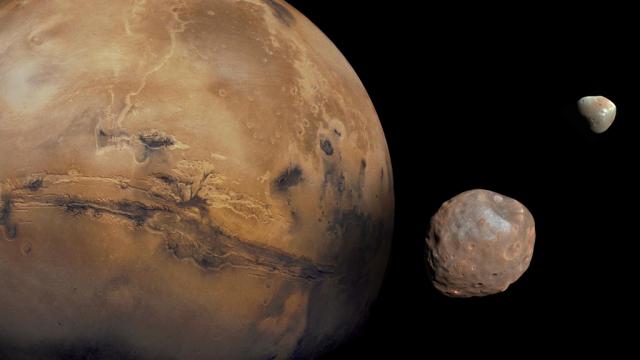Mars’ two moons, Phobos and Deimos, are not so good. They are quite small and abundantly unremarkable. In fact, Mars’ bigger moon, Phobos, is slowly crumbling apart due to stress, which is perhaps its only relatable quality. So how did Mars — a nice, round planet — give rise to such garbage moons? The answer may lie in its turbulent youth, when it was possibly pelted with a large asteroid.
Image: NASA
A new study from researchers at the University of Colorado Boulder offers more evidence for the “single impact hypothesis” around Mars’ geographical mysteries. The idea is that Mars’ unusual topography — such as its wildly different Northern and Southern hemispheres — could be explained by a giant asteroid that blasted Mars about 4.43 billion years ago.
Using computer models to simulate asteroid collision, the researchers posited the asteroid assailant was roughly the same size as the dwarf planet Ceres, which is the largest object in the asteroid belt. In their new paper, which has been published online in the Geophysical Research Letters, the team argues this blast was also responsible for creating a ring of debris that eventually lumped together to form Phobos and Deimos. Now, those lumps are doomed to orbit the Red Planet until one or both implode.
“Mars’ moons are interesting because they have a near equatorial orbit,” co-author Stephen Mojzsis, a professor in CU Boulder’s Department of Geological Sciences, told Gizmodo. “This would be consistent with their origin — not from capture — but by coalescence from a ring of debris that once circled Mars in its early days, over 4.4 billion years ago.”
[referenced url=”https://gizmodo.com.au/2015/11/the-amazingly-creepy-way-mars-will-kill-its-moon/” thumb=”https://i.kinja-img.com/gawker-media/image/upload/t_ku-large/1534542945406816400.png” title=”The Amazingly Creepy Way Mars Will Kill Its Moon” excerpt=”It was a rough month for Phobos, as astronomers decreed — yet again — that Mars is ripping its lumpy moon apart. But apparently, Phobos’ loss is the Red Planet’s gain. After the satellite is torn to pieces, its fragments will fan out into a disk and 20 million years from now, Mars will become a ringed planet.”]
The researchers also looked at Martian meteorites to understand more about the planet’s geographical oddities. Obviously, they found even more questions. The meteorites were chock full of rare metals usually found in the cores of terrestrial planets, including platinum, osmium and iridium, bolstering the researchers’ idea that a large asteroid could have caused their presence.
The single impact hypothesis is not new — in fact, it’s at least 30 years old. Of course, the name is a bit misleading since Mars has been bombarded by asteroids several times over the course of billions of years. Still, it’d be nice to blame something to explain what a majestic planet like Mars did to deserve such unfulfilling moons.
